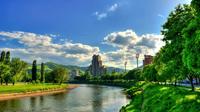Zenica Walking Tour
Zenica, Bosnia Herzegovina
Trip Type: Walking Tours
Duration: Flexible
Walking tour through city of Zenica, in which you will visit major tourist attractions includin Musalla, Wooden Bridge, Seymen Mosque, Monument Stone Sleeper, Downtown, City museum, City synagogue, Marshal Tito's Street, Bosnian National Theatre, Kulin ban Boulevard, Monument park Bilino Polje, National Stadium Bilino Polje.
More About This Activity All Walking Tours →
Walking tour through city of Zenica, in which you will visit major tourist attractions includin Musalla, Wooden Bridge, Seymen Mosque, Monument Stone Sleeper, Downtown, City museum, City synagogue, Marshal Tito's Street, Bosnian National Theatre, Kulin ban Boulevard, Monument park Bilino Polje, National Stadium Bilino Polje. A walking tour through the city of Zenica in total length of 2 hours (2,5 km) with licenced tour guide includes Musalla, locally famous for its purpose of rain pray and Eid pray during Ottoman rule in Bosnia, the oldest graveyard in Zenica and ancient grave monument with interesting background legend. The Wooden Bridge, one of the oldest crossings over river Bosna, which dates from the Roman Empire, the Seymen Mosque, has the oldest stone minaret Bosnia and Herzegovina. It was built in 1506, during Ottoman Empire. The Stone Sleeper“ is monument for civil victims of Defensive-liberation War 1992-1995, the Downtown, the very core of the city of Zenica, including Hadži Mazića's house, old bosnian-style house, beautiful Čaršijska „Downtown“ Mosque and famous Madrasah „Fevzija“.
Continue the tour to the City museum, an institution with rich museum collection of prehistoric, medieval and modern artefacts found in this area, a must-see touristic destination for visitors of Zenica, the City synagougue, one of the most beautiful synagogues in Bosnia and Herzegovina, symbol of settlement of Jews in Zenica, which survived Holocaust. See the building of Bosnian National Theatre, projected by academician Prof Jahiel Finci and Prof Zlatko Ugljen, awarded with The Prise for the best architectural achievement in Bosnia and Herzegovina (1979), as well as The Prise for the best architectural achievement in Yugoslavia (1979). See the Kulin ban Boulevard, a beautiful street along the river Bosna and the most traffic street, the Lamela building, a symbol of socialism, one of the highest Balkan buildings with 25 floors and Bilino Polje, a Monument park and a place where Kulin ban, the ruler of medieval Bosnia, faked declining bogumil religion, and announced himself as a christian, along with his people on the April of 8th 1203. Also see the National stadium Bilino Polje, home of Bosnia and Herzegovina's national football squad and Football club Čelik Zenica.
« Go Back

